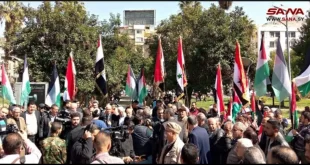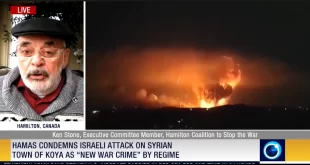May 7, 2015, RT.com
By Sharmine Narwani
This needs to be spelled out: The biggest threat to Middle East stability today is a Sunni one – and it comes not from its largely downtrodden population, but from the epicenter of current Sunni political and religious leadership.
“The beginning of wisdom is to call things by their proper name.” – Confucius
The Shiites have their leadership. So too do Arab Christians, the Druze, Kurds and countless other sects, ethnic groups and tribes in the broader Middle East.
But who looks after the Sunni masses? What major Sunni leader speaks representatively on behalf of these tens of millions of constituents? Who ensures Sunni access to social mobility gives them a voice at the table and champions their key economic and political grievances?
We don’t typically think of majorities this way, but the Sunni Arab may be the single-most disenfranchised segment of the population in the Mideast today – lacking even one major national or regional leader who voices their aspirations.
Lebanese Sidon-based Sunni Sheikh Maher Hammoud is dismayed that issues like the liberation of Palestine, Islamic unity, anti-imperialism, resistance and other populist themes are being viewed as ‘Shia interests’ today – instead of the pan-Arab and pan-Muslim ideals they have traditionally represented.
“These slogans,” he says, “have not sprouted from the Shia Figh (Islamic jurisprudence), but rather from general Islamic Fiqh… But in the last 50 years, there are only two people who deserve the title of ‘Sunni leader’ with a real following: (Egypt’s Arab nationalist President) Gamal Abdel Nasser and (Palestinian Liberation Organization Chairman) Yasser Arafat. Everyone felt that these men represented them.”
“At this point now,” Sheikh Hammoud stresses, “there is nobody to carry the hopes of the Sunni… If one were able to combine the political positions of Iran with the Sunni body, this will form a true launching point for the Muslims.”
Hammoud blames foreign – particularly Israeli and American – interests for creating “artificial” divisions in the Arab/Muslim world to prevent these independent themes from developing into a populist force. And the Saudis, he says, have been their handmaidens in the region:
“Unfortunately, the existence of Saudi Arabia, and its connection with the United States specifically, has prevented any development in this direction,” says the outspoken Sunni cleric, known for his rejection of divisive Shia vs. Sunni, Iranian vs. Arab narratives.
It is a common enough refrain – Hammoud claims a third of Lebanon’s Sunni population share these sentiments – but their voices are muffled by the sectarian and ethnocentric discourse dominating the mainstream, much of it fuelled by Saudi propaganda.
False Gods: Saudi Arabia and Wahhabism
In 2009, Dr. Abdul Latif Arabiyat, a moderate Sunni and founding member of Jordan’s Islamic Action Front – the political arm of the Muslim Brotherhood – told me: “In the first year after the 1979 Islamic revolution in Iran, about 80 books were published on the Shia,” most of them, he says, spinning negative narratives about Iran/Shia; many underwritten by the Saudis.
“I promise you,” Arabiyat continued, “in the many decades before this revolution, there were maybe three or four books on the Shia.”
The Iranians, of course, set about their revolution resuscitating all the populist themes that used to be the mainstay of Arab nationalism: resistance to imperialism, Palestine, rejection of Israel, self-determination – and even Muslim unity, which was seen by the Saudi monarchy as a direct challenge to its perception of itself as keepers of the Islamic faith.
But the Saudis are mainly Wahhabists, a fundamentalist, minority sect of Islam that, at its core, deems other Muslims who do not subscribe to its tenets – including the Shia and other Sunni – as infidels. In their earliest incarnation, says Alastair Crooke, a 20-year veteran of the study of Islamist movements, “their (Wahhabi) strategy – like that of ISIS today – was to bring the peoples whom they conquered into submission. They aimed to instill fear.” And they massacred, pillaged and plundered their way across the Arabian Peninsula in the late 1700s and early 1800s.
Wahhabism, which Orientalist scholar Bernard Lewis calls a “lunatic fringe,” was ‘tidied up’ by the first Saudi King Abd al-Aziz to appeal to the British colonial arbiters of the day. Explains Crooke: It “was forcefully changed from a movement of revolutionary jihad and theological takfiri purification, to a movement of conservative social, political, theological, and religious da’wa (Islamic call) and to justifying the institution that upholds loyalty to the royal Saudi family and the King’s absolute power.”
The Saudi monarchy and Wahhabi clergy struck a deal of sorts – each would uphold the position of the other, and together they would thrive. This union, and what came after, was almost entirely predicated on ‘legitimacy’ bestowed by the British colonial enterprise – and so a third leg makes up this unholy trinity: the unfailing support of Western power.
The Saudi ‘project’ therefore has never been an ‘Arab’ or ‘Muslim’ one. Its very existence depends so completely on a foreign, imperialist benefactor, and all the trappings of that external worldview.
This troika of interests – Wahhabi, Saudi and Western – has always sought a hegemony that cannot possibly flourish in an environment of local populism and self-determination.
Iran’s Islamic Revolution was another in a string of threats that organically undermined Saudi/Wahhabi/Western interests – as did Arab nationalism, the rise of the Muslim Brotherhood, Palestinian resistance, communism and other unifying causes.
From 1979 onward, with an abundance of oil wealth, a convenient Iranian/Shia adversary and the slow encirclement of the Soviet Union, the Saudis took on the task of becoming the Mideast hegemon, Sunni leader and key Western proxy.
Funding Extremism
For decades, Saudi Arabia has liberally plowed its petrodollars into funding projects that support its regional standing. From the early days of building a quite useless, but dazzling, modern infrastructure – to the active establishment of itself as the pre-eminent voice of Sunni Islam (at times, usurping and co-opting the traditional Egyptian center al-Azhar) – the Saudis have ferociously worked to spread their ‘gospel’ and maintain the primacy of their allies.
Nowhere did this turn become as dangerous as in the funding of ‘deviance’ from the traditional Sunni/Sufist path of the majority of Muslims.
The funding and arming of the Afghan Mujahideen in the 1980s to stave off Soviet influence in the region was a Saudi-CIA plan, hatched to great efficacy when Moscow retreated from Afghanistan.
 Displaced Sunni people. (Reuters/Stringer)
Displaced Sunni people. (Reuters/Stringer)
But the plan left disastrous consequences. The Afghan militants were now well-trained and equipped with the kind of destabilizing know-how that has spread into neighboring states and beyond. It is well known that 15 of the 19 alleged perpetrators of 9/11 were Saudi citizens, as well as its alleged mastermind, Osama bin Laden. But less understood is how much the Saudi money-machine continues to fund Al-Qaeda and like-minded groups to this day.
Two years after the September 11 attacks, the US Senate’s Judiciary Committee held an extraordinary hearing on terrorism and its connection to Wahhabism, where Saudi Arabia was called the “epicenter” of terror funding for “principally Al-Qaeda but many other recipients as well.”
According to the testimony of national security expert Alex Alexiev, the Saudis, by their own count, had contributed $70 billion over 25 years to the funding of “what they call Islamist activities.” He continued:
“You are talking about an absolutely astounding amount of money being spent for the specific purpose of promoting, preaching Wahhabi hatred… They have used this amount of money to take over mosques around the world, to establish Wahhabi control of Islamic institutions, subsidize extremist madrassas in South Asia and elsewhere, control Islamic publishing houses. They currently control probably four-fifths of all Islamic publishing houses. And spend money, a lot of it, on aggressive proselytizing, apart from direct support of terrorism.”
Break down these “Islamist” activities to a country like Pakistan, and you have 10,000 Saudi-funded extremist madrassas (schools), one million children being indoctrinated into Wahhabi ideology, 15 percent of whom are foreign youth, 16,000 of whom are Arabs now “perfectly prepared for a career in jihad and extremist activities,” according to Alexiev.
Importantly, he added, the network of 250 Saudi ‘charities’ that funnels money globally, are entirely “government-controlled, government-sponsored, government-funded organizations.” We know this because of a 1993 Saudi law that prohibits “any collection of donations, zakat donations except under state supervision.”
In the years since that unprecedented hearing, we have been told ad nauseam that Washington has taken steps to crack down on its stalwart Saudi ally and that the late King Abdullah was instrumental in reforming the system to prevent the flow of funds to extremists. But evidence continues to suggest that the only hard reforms on this issue were taken internally to thwart terror activities against the Saudi state itself.
Four years after the Senate hearing, Under Secretary of the Treasury Stuart Levey – the lead US official on tracking terror financing – told ABC News that the Saudis had not prosecuted a single person identified as a terror financier by the US and the UN:
“If I could somehow snap my fingers and cut off the funding from one country,” said Levey, “it would be Saudi Arabia.”
In 2009, a secret WikiLeaks cable signed off by US Secretary of State Hillary Clinton reads, in part: “Donors in Saudi Arabia constitute the most significant source of funding to Sunni terrorist groups worldwide…Saudi Arabia remains a critical financial support base for al-Qaeda, the Taliban, LeT (Laskhar-e Taiba), and other terrorist groups…It has been an ongoing challenge to persuade Saudi officials to treat terrorist financing emanating from Saudi Arabia as a strategic priority.”
 Members of al Qaeda’s Nusra Front. (Reuters/Hosam Katan)
Members of al Qaeda’s Nusra Front. (Reuters/Hosam Katan)
Fast-forward to today, and clearly nothing has changed – except the Saudis are now backing terror groups like ISIS. Retired US Senator Bob Graham, a co-chair of the Joint Congressional Inquiry into the 9/11 attacks, connected those dots in an interview last year with Canada’s CBC Radio:
“The connection is a direct one. Not only has Saudi Arabia been promoting this extreme form of religion, but it also has been the principal financier, first of Al-Qaeda then of the various Al-Qaeda franchises around the world specifically the ones in Somalia and Yemen and now the support of ISIS.”
A few months later, US Vice President Joe Biden painted an updated picture of Saudi complicity in terror:
“Our allies in the region were our largest problem in Syria. The Turks…the Saudis, the Emiratis, etc. What were they doing? They were so determined to take down Assad and essentially have a proxy Sunni-Shia war…they poured hundreds of millions of dollars and tens, thousands of tons of weapons into anyone who would fight against Assad except that the people who were being supplied were al-Nusra and Al-Qaeda and the extremist elements of jihadis coming from other parts of the world.”
American complicity
Biden and others, however, fail to mention the United States’ complicity in the Saudi terror-backing project.
Writing about the WikiLeaks missive that revealed Saudi Arabia’s ongoing role in terror financing, the Guardian questioned American meekness in confronting this problem: “Any criticisms are generally offered in private. The cables show that when it comes to powerful oil-rich allies US diplomats save their concerns for closed-door talks.”
In all the current military theaters in the Middle East where extremist Sunni militants are waging wars against Arab populations, the United States is engaged militarily on the same side as the Saudis – to fight the very militancies created by the Saudis.
To compound the craziness, the United States continues to sell eye-popping amounts of heavy weapons to the Saudi government. In the first year of the Arab uprisings, the US Congress approved $67 billion of arms sales to Riyadh – the largest in history – while the British and French keep vying with each other to sell billions more.
Washington has been utterly complicit in backing Saudi Arabia’s ascendance, furnishing it with unprecedented protection and the most sophisticated weapons arsenal money can buy. The US has even trained many of the Wahhabis on the frontlines of global terror – in Afghanistan, Iraq, Syria, Pakistan and elsewhere. How is the US any less of a terrorist-supporter than the Saudis?
Maybe Washington’s problem is not really with ‘terrorism,’ provided it takes place far from US borders, thousands of miles away. Maybe Washington’s main interest is to enable its Saudi proxy to keep a lid on Arab populations, via destabilization if necessary, so that popular Arab sentiments remain unrealized.
Because, under any circumstances other than the Arab realization of self-determination, the Saudi-Wahhabi-western alliance can chug on, unimpeded.
Hijacking the Sunni masses
Meanwhile, back in the real world, the counter-revolutionary forces that actively sought to derail popular Arab uprisings and re-direct them against Saudi-US regional foes, are struggling.
The uprisings were unseating mostly US and Saudi backed autocrats, who spent decades burying popular Arab issues – resuscitating ‘honor and dignity’ slogans about Palestine, representative governance, Muslim unity.
Briefly, the Arab world regained hope as it watched the much-bullied Muslim Brotherhood (MB) rise to leadership positions in several states. That optimism turned quickly to despair as the MB instead supported external attacks on Syria, fanned the flames of sectarianism and kept a chilling silence over Israel’s 2012 military devastation of the Gaza Strip.
 Muslim Brotherhood’s senior member Mohamed El-Beltagy (R) and deputy head of the Freedom and Justice Party Essam El-Erian (L) gesture the four-finger Rabia sign from behind bars with other Muslim Brotherhood members at a court in the outskirts of Cairo, April 21, 2015. (Reuters/Amr Abdallah Dalsh)
Muslim Brotherhood’s senior member Mohamed El-Beltagy (R) and deputy head of the Freedom and Justice Party Essam El-Erian (L) gesture the four-finger Rabia sign from behind bars with other Muslim Brotherhood members at a court in the outskirts of Cairo, April 21, 2015. (Reuters/Amr Abdallah Dalsh)
Sunni masses in Egypt and Tunisia rejected this new Sunni leadership – and the popularity of Turkish MB President Recep Tayyip Erdogan plummeted alongside.
The Saudis helped to oust the MB, and have essentially bought or bullied their way back into the top-dog position in the Arab world today. But in doing so – and by leading the counter-revolution – they solicited the help of the extremists that have set the region aflame.
Arabs realize this. The Saudi project is faltering as it turns Yemen to dust, escalates in Syria and Iraq, tries to prop up Bahrain and confronts Muslim Iran. And Saudi popularity is taking unprecedented hits among the Arab Sunni masses.
A 2013 Pew poll revealed that “Saudi Arabia’s standing has slipped substantially among key Middle Eastern publics,” dropping (since 2007) by 13 percent in Egypt and the Palestinian territories, 14 percent in Turkey, and a whopping 31 percent in Lebanon. Since Riyadh’s unpopular bombing of Yemen began in late March, majority-Sunni Pakistanis have loudly rejected participating as paid foot soldiers in another of the Kingdom’s wars. And Egyptians, who have benefitted to the tune of billions of dollars in Saudi largesse, have turned on their benefactors too in countless editorials and personal swipes at Saudi royals. And a majority of suicide bombers in Iraq today are Saudi nationals – further decimating support from that war-torn neighbor.
Riyadh’s sectarian projects are also faltering. After brokering an unholy union between Iraq’s secular Baathists and ISIS, last week 80 Sunni tribal leaders reached out to Shia militias to help them retake the Anbar Province from the Takfiri militants. In Syria, it is a Saudi/Turkish/US/Qatari-led alliance that has brought together Al-Qaeda and co-extremists to wrest control in the north from the Syrian army, most of whose rank and file are Sunni.
The destabilization has seeped throughout the region, making the life of the disenfranchised Sunni majority – most of whom are under the age of 30 and poor – worse than ever before.
Would there be ISIS-Al-Qaeda-Al-Nusra-Taliban-Ansar-Al-Sharia-Al-Shabab-Boko-Haram if Saudi Arabia and its extremist Wahhabi ideology did not exist? Certainly not. Would there be a Saudi Arabia this empowered if it were not coddled, protected and weaponized by the United States? Certainly not.
There is a Sunni problem in the Middle East today. And it is going to get bigger, exponentially – unless, in common Saudi-parlance, you “cut off the head of the snake.” The Sunni may not have much in terms of leadership, but this Wahhabi beheading may be the only thing that allows them the freedom to mobilize behind genuine aspirations.
 Syria Support Movement solidarity with the Syrian people
Syria Support Movement solidarity with the Syrian people




